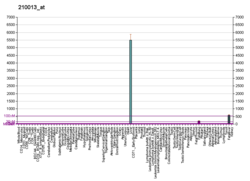헤모펙신
Hemopexin| HPX | |||||||||||||||||||||||||||||||||||||||||||||||||||
|---|---|---|---|---|---|---|---|---|---|---|---|---|---|---|---|---|---|---|---|---|---|---|---|---|---|---|---|---|---|---|---|---|---|---|---|---|---|---|---|---|---|---|---|---|---|---|---|---|---|---|---|
| 식별자 | |||||||||||||||||||||||||||||||||||||||||||||||||||
| 에일리어스 | HPX, HX, 헤모펙신 | ||||||||||||||||||||||||||||||||||||||||||||||||||
| 외부 ID | OMIM: 142290 MGI: 105112 HomoloGene: 511 GeneCard: HPX | ||||||||||||||||||||||||||||||||||||||||||||||||||
| |||||||||||||||||||||||||||||||||||||||||||||||||||
| |||||||||||||||||||||||||||||||||||||||||||||||||||
| |||||||||||||||||||||||||||||||||||||||||||||||||||
| |||||||||||||||||||||||||||||||||||||||||||||||||||
| |||||||||||||||||||||||||||||||||||||||||||||||||||
| 위키데이터 | |||||||||||||||||||||||||||||||||||||||||||||||||||
| |||||||||||||||||||||||||||||||||||||||||||||||||||
헤모펙신(또는 헤모펙신; Hpx; Hx)은 인간에서 HPX[5][6][7] 유전자에 의해 암호화되어 단백질의 [8]헤모펙신 계열에 속하는 당단백질이다.헤모펙신은 헴에 [9]대한 결합 친화력이 가장 높은 혈장 단백질이다.
혈장에서 홀로 순환하는 헤모글로빈 자체는 곧 메트헤모글로빈으로 산화되며, 메트헤모글로빈은 글로빈 사슬과 함께 유리헤모글로빈으로 더욱 분리된다.유리 헴은 유리 헴으로 산화되며 조만간 헤모펙신이 유리 헴과 결합해 헴과 헤모펙신의 복합체를 형성하고 CD91과 같은 비장, 간 및 골수 [10]내의 대식세포 또는 대식세포에 도달할 때까지 순환에서 이들의 여정을 계속한다.
헤모펙신의 도착과 유리 헴에 대한 후속 결합은 헴의 산화방지 및 염증방지 효과를 예방할 뿐만 아니라 유리 헴의 [10]해독을 촉진한다.
헤모펙신은 합토글로빈과 다르며, 합토글로빈은 항상 유리 [11][10]헤모글로빈과 결합합니다.(햅토글로빈 different 헤모펙신과의 분화 참조)
클로닝, 표현 및 검출
Takahashi et al.(1985)는 인간 혈장 Hx가 439개의 아미노산 잔기로 이루어진 단일 폴리펩타이드 사슬과 6개의 인트라아인 디술피드 브릿지로 구성되며 분자 질량은 약 63kD라고 결정했다.아미노 말단 트레오닌 잔기는 뮤신형 O-결합 갈락토사민 올리고당에 의해 수식되며 단백질은 5개의 N-결합 글리칸 수식을 가진다.18개의 트립토판 잔기는 4개의 클러스터로 배열되며, 12개의 트립토판은 상동 위치에 보존된다.아미노산 배열의 내부 호몰로지에 대한 컴퓨터 지원 분석은 조상 유전자의 복제를 제안했고, 따라서 Hx가 두 개의 유사한 [12]반쪽들로 구성되어 있음을 나타낸다.
Altruda 외 연구진(1988)은 HPX 유전자가 약 12kb에 걸치고 9엑손에 의해 간섭된다는 것을 입증했다.이 시연은 엑손과 단백질의 10가지 반복 단위 사이의 직접적인 상관관계를 보여준다.인트론은 무작위로 배치된 것이 아니라 아미노산 배열 호몰로지 영역의 중앙에서 10개 단위 중 6개 단위에서 현저하게 유사한 위치와 코드 배열의 각 절반에서 대칭 위치에 떨어졌다.이러한 관찰로부터 알트루다 외 연구진(1988)은 유전자가 원시 배열의 인트론 매개 복제를 통해 5-엑손 [13]클러스터로 진화했다고 결론지었다.
헤모펙신유전자매핑
Cai와 Law(1986)는 인간 염색체의 다른 조합을 포함하는 인간/햄스터 하이브리드의 서던 블롯 분석을 통해 Hx용 cDNA 클론을 준비했고, HPX 유전자를 인간 염색체 11에 할당했다.Law et al.(1988)는 HPX 유전자를 현장 [14]교잡에 의한 베타글로빈 유전자 복합체와 동일한 위치인 11p15.5-p15.4에 할당했다.
헤모펙신 유전자의 차이 전사 패턴
1986년, 다른 인체 조직과 세포주에서의 인간 HPX 유전자의 발현이 특정 cDNA 프로브를 사용하여 수행되었다.얻은 결과로부터, 이 유전자는 간에서 발현되어 검사된 다른 조직이나 세포주에서의 검출 레벨보다 낮다는 결론을 얻었다.S1 매핑에 의해 간세포의 전사 개시 부위는 헤모펙신 [15]유전자의 AUG 개시 코돈에서 상류로 28개의 염기쌍을 위치시켰다.
기능.
Hx는 알려진 단백질 [9]중 가장 높은 친화력으로 헴을 결합시킨다.그것의 주요 기능은 헤모글로빈과 같은 헴 단백질의 회전에 의해 방출되거나 손실된 헴을 청소하는 것이며, 따라서 유리 헴이 야기할 수 있는 산화적 손상으로부터 몸을 보호하는 것입니다.또한 Hx는 CD91과 [16]상호작용할 때 내부화를 위해 결합 배위자를 방출한다.Hx는 인체의 [17]철분을 보존한다.세포외 헴의 Hx의존성 흡수는 항산화 헴산소화효소-1 유전자의 전사활성화로 이어지는 바흐1억제 불활성화를 초래할 수 있다.헤모글로빈, 합토글로빈(Hp) 및 Hx는 고밀도 리포단백질(HDL)과 결합하여 HDL의 [18]염증 특성에 영향을 미칩니다. Hx는 시험관 [19]내에서 앤지오텐신 II Type 1 수용체(AT1-R)를 다운 조절합니다.
임상적 의의
순환 Hx의 주요 공급원은 [20]혈장 농도가 1~2mg/ml인 간이다.혈청 Hx 수치는 혈액에 헴이 얼마나 많이 존재하는지 나타냅니다.따라서 Hx 수치가 낮으면 화합물을 함유한 헴의 분해가 현저하게 이루어지고 있음을 나타낸다.낮은 Hx 수치는 혈관 내 용혈성 [21]빈혈의 진단 특징 중 하나이다.Hx는 심혈관 질환, 패혈성 쇼크, 뇌허혈성 손상, 그리고 실험적인 자가면역성 [22]뇌척수염에 관련되어 있다.Hx의 순환 수치는 패혈성 [22]쇼크 환자의 예후와 관련이 있다.
HPX는 [23]뇌에서 생성됩니다.HPX 유전자의 결실은 스트로마 프리 헤모글로빈 유도 뇌내 출혈에 [24]이어 뇌 손상을 악화시킬 수 있다.뇌척수액 중 높은 Hx 수치는 지주막하 출혈 [23]후 좋지 않은 결과와 관련이 있다.
합토글로빈과의 관계
과거 겸상적혈구병, 구상세포증, 자가면역용혈성 빈혈, 적혈구형성 프로토포르피리아 및 피루브산인산화효소 결핍증 환자에서 Hx 농도의 저하가 심각하거나 장기간 [20]용혈로 인해 햅토글로빈(Hp) 농도가 낮아지거나 고갈되는 상황에서 발생한다는 보고가 있었다.Hp와 Hx는 모두 급성상 단백질로, 조직 손상을 최소화하고 조직 [9]복구를 용이하게 하기 위해 감염 중 및 염증 상태 후에 합성이 유도된다.Hp와 Hx는 단구 또는 대식세포가 도착하기 전에 스스로를 헴에 결합하여 [9]헴 독성을 방지하며, 이는 여러 질병에서 결과에 미치는 영향을 설명할 수 있으며 용혈 또는 출혈 [25]상태의 치료 단백질로서 외인성 Hp와 Hx의 근거를 뒷받침한다.헤모펙신은 [9]혈장 내 헴을 운반하는 주요 매개체이다.
레퍼런스
- ^ a b c GRCh38: 앙상블 릴리즈 89: ENSG00000110169 - 앙상블, 2017년 5월
- ^ a b c GRCm38: 앙상블 릴리즈 89: ENSMUSG000030895 - 앙상블, 2017년 5월
- ^ "Human PubMed Reference:". National Center for Biotechnology Information, U.S. National Library of Medicine.
- ^ "Mouse PubMed Reference:". National Center for Biotechnology Information, U.S. National Library of Medicine.
- ^ "Entrez Gene: HPX hemopexin".
- ^ Altruda F, Poli V, Restagno G, Silengo L (1988). "Structure of the human hemopexin gene and evidence for intron-mediated evolution". Journal of Molecular Evolution. 27 (2): 102–8. Bibcode:1988JMolE..27..102A. doi:10.1007/BF02138368. PMID 2842511. S2CID 11271490.
- ^ Altruda F, Poli V, Restagno G, Argos P, Cortese R, Silengo L (June 1985). "The primary structure of human hemopexin deduced from cDNA sequence: evidence for internal, repeating homology". Nucleic Acids Research. 13 (11): 3841–59. doi:10.1093/nar/13.11.3841. PMC 341281. PMID 2989777.
- ^ Bode W (June 1995). "A helping hand for collagenases: the haemopexin-like domain". Structure. 3 (6): 527–30. doi:10.1016/s0969-2126(01)00185-x. PMID 8590012.
- ^ a b c d e Tolosano E, Altruda F (April 2002). "Hemopexin: structure, function, and regulation". DNA and Cell Biology. 21 (4): 297–306. doi:10.1089/104454902753759717. PMID 12042069.
- ^ a b c "Intravascular hemolysis". eClinpath. Retrieved 2019-05-08.
- ^ "Bilirubin and hemolytic anemia". eClinpath. Retrieved 2019-05-08.
- ^ 온라인 Mendelian In Man (OMIM) : 직립불내증 - 604715
- ^ Takahashi N, Takahashi Y, Putnam FW (January 1985). "Complete amino acid sequence of human hemopexin, the heme-binding protein of serum". Proceedings of the National Academy of Sciences of the United States of America. 82 (1): 73–7. Bibcode:1985PNAS...82...73T. doi:10.1073/pnas.82.1.73. PMC 396973. PMID 3855550.
- ^ 온라인 Mendelian In Man (OMIM) : 헤모펙신 - 142290
- ^ Poli V, Altruda F, Silengo L (1986). "Differential transcriptional pattern of the hemopexin gene". The Italian Journal of Biochemistry. 35 (5): 355–60. PMID 3026994.
- ^ Hvidberg V, Maniecki MB, Jacobsen C, Højrup P, Møller HJ, Moestrup SK (October 2005). "Identification of the receptor scavenging hemopexin-heme complexes". Blood. 106 (7): 2572–9. doi:10.1182/blood-2005-03-1185. PMID 15947085.
- ^ Tolosano E, Altruda F (April 2002). "Hemopexin: structure, function, and regulation". DNA and Cell Biology. 21 (4): 297–306. doi:10.1089/104454902753759717. PMID 12042069.
- ^ Watanabe J, Grijalva V, Hama S, Barbour K, Berger FG, Navab M, Fogelman AM, Reddy ST (July 2009). "Hemoglobin and its scavenger protein haptoglobin associate with apoA-1-containing particles and influence the inflammatory properties and function of high density lipoprotein". The Journal of Biological Chemistry. 284 (27): 18292–301. doi:10.1074/jbc.m109.017202. PMC 2709397. PMID 19433579.
- ^ Krikken JA, Lely AT, Bakker SJ, Borghuis T, Faas MM, van Goor H, Navis G, Bakker WW (March 2013). "Hemopexin activity is associated with angiotensin II responsiveness in humans". Journal of Hypertension. 31 (3): 537–41, discussion 542. doi:10.1097/HJH.0b013e32835c1727. PMID 23254305. S2CID 23501030.
- ^ a b Muller-Eberhard U, Javid J, Liem HH, Hanstein A, Hanna M (November 1968). "Plasma concentrations of hemopexin, haptoglobin and heme in patients with various hemolytic diseases". Blood. 32 (5): 811–5. doi:10.1182/blood.V32.5.811.811. PMID 5687939.
- ^ Hoffbrand A, Moss P, Pettit J (2006). Essential Haematology (5th ed.). Oxford: Blackwell Publishing. p. 60. ISBN 978-1-4051-3649-5.
- ^ a b Mehta NU, Reddy ST (October 2015). "Role of hemoglobin/heme scavenger protein hemopexin in atherosclerosis and inflammatory diseases". Current Opinion in Lipidology. 26 (5): 384–7. doi:10.1097/MOL.0000000000000208. PMC 4826275. PMID 26339767.
- ^ a b Garland P, Durnford AJ, Okemefuna AI, Dunbar J, Nicoll JA, Galea J, Boche D, Bulters DO, Galea I (March 2016). "Heme-Hemopexin Scavenging Is Active in the Brain and Associates With Outcome After Subarachnoid Hemorrhage" (PDF). Stroke. 47 (3): 872–6. doi:10.1161/strokeaha.115.011956. PMID 26768209. S2CID 11532383.
- ^ Ma B, Day JP, Phillips H, Slootsky B, Tolosano E, Doré S (February 2016). "Deletion of the hemopexin or heme oxygenase-2 gene aggravates brain injury following stroma-free hemoglobin-induced intracerebral hemorrhage". Journal of Neuroinflammation. 13: 26. doi:10.1186/s12974-016-0490-1. PMC 4736638. PMID 26831741.
- ^ Schaer DJ, Vinchi F, Ingoglia G, Tolosano E, Buehler PW (2014). "Haptoglobin, hemopexin, and related defense pathways-basic science, clinical perspectives, and drug development". Frontiers in Physiology. 5: 415. doi:10.3389/fphys.2014.00415. PMC 4211382. PMID 25389409.
추가 정보
- Piccard H, Van den Steen PE, Opdenakker G (April 2007). "Hemopexin domains as multifunctional liganding modules in matrix metalloproteinases and other proteins". Journal of Leukocyte Biology. 81 (4): 870–92. doi:10.1189/jlb.1006629. PMID 17185359. S2CID 16210789.
- Morgan WT, Muller-Eberhard U, Lamola AA (January 1978). "Interaction of rabbit hemopexin with bilirubin". Biochimica et Biophysica Acta (BBA) - Protein Structure. 532 (1): 57–64. doi:10.1016/0005-2795(78)90447-6. PMID 620056.
- Liu HM, Atack JR, Rapoport SI (1989). "Immunohistochemical localization of intracellular plasma proteins in the human central nervous system". Acta Neuropathologica. 78 (1): 16–21. doi:10.1007/BF00687397. PMID 2735186. S2CID 24415663.
- Smith A, Tatum FM, Muster P, Burch MK, Morgan WT (April 1988). "Importance of ligand-induced conformational changes in hemopexin for receptor-mediated heme transport". The Journal of Biological Chemistry. 263 (11): 5224–9. doi:10.1016/S0021-9258(18)60703-3. PMID 2833500.
- Altruda F, Poli V, Restagno G, Silengo L (1988). "Structure of the human hemopexin gene and evidence for intron-mediated evolution". Journal of Molecular Evolution. 27 (2): 102–8. Bibcode:1988JMolE..27..102A. doi:10.1007/BF02138368. PMID 2842511. S2CID 11271490.
- Altruda F, Poli V, Restagno G, Argos P, Cortese R, Silengo L (June 1985). "The primary structure of human hemopexin deduced from cDNA sequence: evidence for internal, repeating homology". Nucleic Acids Research. 13 (11): 3841–59. doi:10.1093/nar/13.11.3841. PMC 341281. PMID 2989777.
- Taketani S, Kohno H, Naitoh Y, Tokunaga R (June 1987). "Isolation of the hemopexin receptor from human placenta". The Journal of Biological Chemistry. 262 (18): 8668–71. doi:10.1016/S0021-9258(18)47465-0. PMID 3036819.
- Law ML, Cai GY, Hartz JA, Jones C, Kao FT (July 1988). "The hemopexin gene maps to the same location as the beta-globin gene cluster on human chromosome 11". Genomics. 3 (1): 48–52. doi:10.1016/0888-7543(88)90158-9. PMID 3220477.
- Morgan WT, Alam J, Deaciuc V, Muster P, Tatum FM, Smith A (June 1988). "Interaction of hemopexin with Sn-protoporphyrin IX, an inhibitor of heme oxygenase. Role for hemopexin in hepatic uptake of Sn-protoporphyrin IX and induction of mRNA for heme oxygenase". The Journal of Biological Chemistry. 263 (17): 8226–31. doi:10.1016/S0021-9258(18)68467-4. PMID 3372522.
- Takahashi N, Takahashi Y, Putnam FW (January 1985). "Complete amino acid sequence of human hemopexin, the heme-binding protein of serum". Proceedings of the National Academy of Sciences of the United States of America. 82 (1): 73–7. Bibcode:1985PNAS...82...73T. doi:10.1073/pnas.82.1.73. PMC 396973. PMID 3855550.
- Takahashi N, Takahashi Y, Putnam FW (April 1984). "Structure of human hemopexin: O-glycosyl and N-glycosyl sites and unusual clustering of tryptophan residues". Proceedings of the National Academy of Sciences of the United States of America. 81 (7): 2021–5. Bibcode:1984PNAS...81.2021T. doi:10.1073/pnas.81.7.2021. PMC 345428. PMID 6371807.
- Frantíková V, Borvák J, Kluh I, Morávek L (December 1984). "Amino acid sequence of the N-terminal region of human hemopexin". FEBS Letters. 178 (2): 213–6. doi:10.1016/0014-5793(84)80603-1. PMID 6510521. S2CID 45009902.
- Smith A, Alam J, Escriba PV, Morgan WT (April 1993). "Regulation of heme oxygenase and metallothionein gene expression by the heme analogs, cobalt-, and tin-protoporphyrin". The Journal of Biological Chemistry. 268 (10): 7365–71. doi:10.1016/S0021-9258(18)53184-7. PMID 8463269.
- Morris CM, Candy JM, Edwardson JA, Bloxham CA, Smith A (January 1993). "Evidence for the localization of haemopexin immunoreactivity in neurones in the human brain". Neuroscience Letters. 149 (2): 141–4. doi:10.1016/0304-3940(93)90756-B. PMID 8474687. S2CID 24743139.
- Hrkal Z, Kuzelová K, Muller-Eberhard U, Stern R (March 1996). "Hyaluronan-binding properties of human serum hemopexin". FEBS Letters. 383 (1–2): 72–4. doi:10.1016/0014-5793(96)00225-6. PMID 8612795. S2CID 21283343.
- Hunt RC, Hunt DM, Gaur N, Smith A (July 1996). "Hemopexin in the human retina: protection of the retina against heme-mediated toxicity". Journal of Cellular Physiology. 168 (1): 71–80. doi:10.1002/(SICI)1097-4652(199607)168:1<71::AID-JCP9>3.0.CO;2-5. PMID 8647924.
- Miller YI, Smith A, Morgan WT, Shaklai N (October 1996). "Role of hemopexin in protection of low-density lipoprotein against hemoglobin-induced oxidation". Biochemistry. 35 (40): 13112–7. doi:10.1021/bi960737u. PMID 8855948.
- Grinberg LN, O'Brien PJ, Hrkal Z (July 1999). "The effects of heme-binding proteins on the peroxidative and catalatic activities of hemin". Free Radical Biology & Medicine. 27 (1–2): 214–9. doi:10.1016/S0891-5849(99)00082-9. PMID 10443938.
- Nakajima S, Moriyama T, Hayashi H, Sakata I, Nakae Y, Takemura T (February 2000). "Hemopexin as a carrier protein of tumor-localizing Ga-metalloporphyrin-ATN-2". Cancer Letters. 149 (1–2): 221–6. doi:10.1016/S0304-3835(99)00367-5. PMID 10737728.
- Shipulina N, Smith A, Morgan WT (April 2000). "Heme binding by hemopexin: evidence for multiple modes of binding and functional implications". Journal of Protein Chemistry. 19 (3): 239–48. doi:10.1023/A:1007016105813. PMID 10981817. S2CID 45510572.








